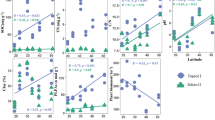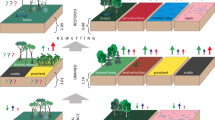Abstract
The Arctic treeline is advancing in many areas and changes in carbon (C) cycling are anticipated. Differences in CO2 exchange between adjacent forest and tundra are not well known and contrasting conclusions have been drawn about the effects of forest advance on ecosystem C stocks. Measurements of CO2 exchange in tundra and adjacent forest showed the forest was a greater C sink during the growing season in northern Canada. There is, however, reason to expect that forests lose more C than tundra during the wintertime, as forests may accumulate and retain more snow. Deeper snow insulates the soil and warmer soils should lead to greater rates of belowground respiration and CO2 efflux. In this study, I tested the hypotheses that forests maintain a deeper snowpack, have warmer soils and lose more C during winter than adjacent tundra near the Arctic treeline in northwest Alaska. Measurements of snow depth, soil temperature and CO2 efflux were made at five forest and two treeline sites in late winter of three consecutive years. Snow depth and soil temperature were greater in forest than treeline sites, particularly in years with higher snowfall. There was a close exponential correlation between soil temperature and CO2 efflux across sites and years. The temperature-efflux model was driven using hourly soil temperatures from all the sites to provide a first approximation of the difference in winter C loss between treeline and forest sites. Results showed that greater wintertime C loss from forests could offset greater summertime C gain.






Similar content being viewed by others
References
Beringer J, Chapin FS III, Thompson CC, McGuire AD (2005) Surface energy exchanges along a tundra-forest transition and feedbacks to climate. Agric For Meteorol 131:143–161
Bowling DR, Massman WJ, Schaeffer SM, Burns SP, Monson RK, Williams MW (2009) Biological and physical influences on the carbon isotope content of CO2 in a subalpine forest snowpack, Niwot Ridge, Colorado. Biogeochemistry 95:37–59
Brooks PD, Schmidt SK, Williams MW (1997) Winter production of CO2 and N2O from alpine tundra: environmental controls and relationship to inter-system C and N fluxes. Oecologia 110:403–413
Brooks PD, Campbell DH, Tonnessen KA, Heuer K (1999) Natural variability in N export from headwater catchments: snow cover controls on ecosystem N retention. Hydrol Process 13:2191–2201
Brooks PD, McKnight D, Elder K (2004) Carbon limitation of soil respiration under winter snowpacks: potential feedbacks between growing season and winter carbon fluxes. Glob Change Biol 11:231–238
Chapin FS III, McGuire AD, Randerson J, Pielke R Sr, Baldocchi D, Hobbie SE, Roulet N, Eugster W, Kasischke E, Rastetter EB, Zimov SA, Running SW (2000a) Arctic and boreal ecosystems of western North America as components of the climate system. Glob Change Biol 6(suppl 1):211–223
Chapin FS III, Eugster W, McFadden JP, Lynch AH, Walker DA (2000b) Summer differences among arctic ecosystems in regional climate forcing. J Climate 13:2002–2010
Elder K, Dozier J, Michaelsen J (1991) Snow accumulation and distribution in an alpine watershed. Water Resour Res 27:1541–1552
Fahnestock JT, Jones MH, Brooks PD, Walker DA, Welker JM (1998) Winter and early spring CO2 efflux from tundra communities of northern Alaska. J Geophys Res 103:29023–29027
Fahnestock JT, Jones MH, Welker JM (1999) Wintertime CO2 efflux from arctic soils: implications for annual carbon budgets. Global Biogeochem Cycles 13:775–779
Greene EM, Liston GE, Pielke RA Sr (1999) Simulation of above treeline snowdrift formation using a numerical snow-transport model. Cold Reg Sci Technol 30:135–144
Grogan P, Chapin FS III (1999) Arctic soil respiration: effects of climate and vegetation depend on season. Ecosystems 2:451–459
Hiemstra CA, Liston GE, Reiners WA (2002) Snow redistribution by wind and interactions with vegetation at upper treeline in the Medicine Bow Mountains, Wyoming, USA. Arct Antarct Alp Res 34:262–273
Hubbard RM, Ryan MG, Elder K, Rhoades CC (2005) Seasonal patterns in soil surface CO2 flux under snow cover in 50 and 300 year old subalpine forests. Biogeochemistry 73:93–107
Ilvesniemi H, Kähkönen MA, Pumpanen J, Rannik U, Wittmann C, Perämäki M, Keronen P, Hari P, Vesala T, Salkinoja-Salonen M (2005) Wintertime CO2 evolution from a boreal forest ecosystem. Boreal Environ Res 10:401–408
Jones MH, Fahnestock JT, Welker JM (1999a) Early and late winter CO2 efflux from arctic tundra in the Kuparuk River Watershed, Alaska, USA. Arct Antarct Alp Res 31:187–190
Jones HG, Pomeroy JW, Davies TD, Tranter M, Marsh P (1999b) CO2 in Arctic snow cover: landscape form, in-pack gas concentration gradients, and the implications for the estimation of gaseous fluxes. Hydrol Process 13:2977–2989
Kelly JJ Jr, Weaver DF, Smith BP (1968) The variation of carbon dioxide under the snow in the Arctic. Ecology 49:358–361
Kim Y, Ueyama M, Nakagawa F, Tsunogai U, Harozono Y, Tanaka N (2007) Assessment of winter fluxes of CO2 and CH4 in boreal forest soils of central Alaska estimated by the profile method and the chamber method: a diagnosis of methane emission and implications for the regional carbon budget. Tellus 59B:223–233
LaFleur PM, Griffis TJ, Rouse WR (2001) Inter-annual variability in net CO2 exchange at the Arctic treeline. Arct Antarct Alp Res 33:149–157
Lavoie C, Payette S (1996) The long-term stability of the boreal forest limit in subarctic Quebec. Ecology 77:1226–1233
Liptzin D, Williams MW, Helmig D, Seok B, Filippa G, Chowanski K, Hueber J (2009) Process-level controls on CO2 fluxes from a seasonally snow-covered subalpine meadow soil, Niwot Ridge, Colorado. Biogeochemistry 95:151–166
Lloyd AH, Rupp TS, Fastie CL, Starfield AM (2003) Patterns and dynamics of treeline advance on the Seward Peninsula, Alaska. J Geophys Res 108:8161
MacDonald GM, Sceicz JM, Claricoates J, Dale KA (1998) Response of the central Canadian tree line to recent climatic changes. Ann Assoc Am Geogr 88:183–208
MacDonald GM, Kremenetski KV, Beilman DW (2008) Climate change and the northern Russian treeline zone. Philos T Roy Soc B 1501:2285–2299
Massman WJ (2006) Advective transport of CO2 in permeable media induced by atmospheric pressure fluctuations: 1. An analytical model. J Geophys Res 111:G03004
Massman WJ, Frank JM (2006) Advective transport of CO2 in permeable media induced by atmospheric pressure fluctuations: 2. Observational evidence under snowpacks. J Geophys Res 111:G03005
Massman WJ, Sommerfeld RA, Zeller K, Hehn T, Hudnell L, Rochelle SG (1995) CO2 flux through a Wyoming seasonal snowpack: diffusional and pressure pumping effects. Biogeochemistry of snow-covered catchments. International Association of Hydrological Sciences, Wallingford, pp 71–79
Massman WJ, Sommerfeld RA, Mosier AR, Zeller KF, Hehn TJ, Rochelle SG (1997) A model investigation of turbulence-driven pressure-pumping effects on the rate of diffusion of CO2, N2O, and CH4 through layered snowpacks. J Geophys Res 102:18851–18863
Mast MA, Wickland KP, Striegl RT, Clow DW (1998) Winter fluxes of CO2 and CH4 from subalpine soil in Rocky Mountain National Park, Colorado. Global Biogeochem Cycles 12:607–620
McDowell NG, Marshall JD, Hooker TD, Musselman R (2000) Estimating CO2 flux from snowpacks at three sites in the Rocky Mountains. Tree Physiol 20:745--753
Mikan CJ, Schimel JP, Doyle AP (2002) Temperature controls of microbial respiration in arctic tundra soils above and below freezing. Soil Biol Biochem 34:1785–1795
Millington RJ (1959) Gas diffusion in porous media. Science 130:100–102
Musselman RC, Massman WJ, Frank JM, Korfmacher JL (2005) The temporal dynamics of carbon dioxide under snow in a high elevation Rocky Mountain subalpine forest and meadow. Arct Antarct Alp Res 37:527–538
Oechel WC, Vourlitis G, Hastings SJ (1997) Cold season CO2 emission from arctic soils. Global Biogeochem Cycles 11:163–172
Olsson PQ, Sturm M, Racine CH, Romanovsky V, Liston GE (2003) Five stages of the Alaskan Arctic cold season with ecosystem implications. Arct Antarct Alp Res 35:74–81
Panikov NS, Dedysh SN (2000) Cold season CH4 and CO2 emission from boreal peat bogs (West Siberia): winter fluxes and thaw activation dynamics. Global Biogeochem Cycles 14:1071–1080
Panikov NS, Flanagan PW, Oechel WC, Mastepanov MA, Christensen TR (2006) Microbial activity in soils frozen to below −39 degrees C. Soil Biol Biochem 38:785–794
Schimel JP, Bilbrough C, Welker JM (2004) Increased snow depth affects microbial activity and nitrogen mineralization in two arctic tundra communities. Soil Biol Biochem 36:217–227
Schimel JP, Fahnestock J, Michaelson G, Mikan C, Ping C-L, Romanovsky VE, Welker J (2006) Cold-season production of CO2 in arctic soils: can laboratory and field estimates be reconciled through a simple modeling approach? Arct Antarct Alp Res 38:249–256
Schindlbacher A, Zechmeister-Boltenstern S, Glatzel G, Jandl R (2007) Winter soil respiration from an Austrian mountain forest. Agric For Meteorol 146:205–215
Seok B, Helmig D, Williams MW, Liptzin D, Chowanski K, Hueber J (2009) An automated system for continuous measurements of trace gas fluxes through snow: an evaluation of the gas diffusion method at a subalpine forest site, Niwot Ridge, Colorado. Biogeochemistry 95:95–113
Soil Survey Staff (1998) Keys to soil taxonomy. Natural Resource Conservation Service. United States Department of Agriculture, Washington, DC
Steltzer H (2004) Soil carbon sequestration with forest expansion in an arctic forest-tundra landscape. Can J For Res 34:1538–1542
Stottlemyer R (2001) Biogeochemistry of a treeline watershed, northwestern Alaska. J Environ Qual 30:1990–1998
Sturm M, McFadden JP, Liston GE, Chapin FS III, Racine CH, Holmgren J (2001) Snow-shrub interactions in arctic tundra: a hypothesis with climatic implications. J Climate 14:336–344
Sturm M, Schimel J, Michaelson G, Welker JM, Oberbauer SF, Liston GE, Fahnestock J, Romanovsky VE (2005) Winter biological processes could help convert arctic tundra to shrubland. Bioscience 55:17–26
Suarez F, Binkley D, Kaye MW, Stottlemyer R (1999) Expansion of forest stands into the tundra in Noatak National Preserve, northwest Alaska. Ecoscience 6:465–470
Sullivan PF, Welker JM, Arens SJT, Sveinbjörnsson B (2008) Continuous estimates of CO2 efflux from arctic and boreal soils during the snow-covered season in Alaska. J Geophys Res 113:G04009
Vogel JG, Valentine DW, Ruess RW (2005) Soil and root respiration in mature Alaskan black spruce forests that vary in soil organic matter decomposition rates. Can J For Res 35:161–174
Wang C, Bond-Lamberty B, Gower ST (2002) Soil surface CO2 flux in a boreal black spruce fire chronosequence. J Geophys Res 108:8224
Welker JM, Fahnestock JM, Jones MH (2000) Annual CO2 flux in dry and moist arctic tundra: field responses to increases in summer temperatures and winter snow depth. Clim Change 44:139–150
Wilmking M, Harden J, Tape K (2006) Effect of treeline advance on carbon storage in NW Alaska. J Geophys Res 111:G02023
Winston GC, Sundquist ET, Stephens BB, Trumbore SE (1997) Winter CO2 fluxes in a boreal forest. J Geophys Res 102:28795–28804
Zimov SA, Zimova GM, Daviodov SP, Daviodova AI, Voropaev YV, Voropaeva ZV, Prosiannikov SF, Prosiannikova OV, Semiletova IV, Semiletov IP (1993) Winter biotic activity and production of CO2 in Siberian soils: a factor in the greenhouse effect. J Geophys Res 98:5017–5023
Zimov SA, Daviodov SP, Voropaev YV, Prosiannikov SF, Semiletov IP, Chapin MC, Chapin FS (1996) Siberian CO2 efflux in winter as a CO2 source and cause of seasonality in atmospheric CO2. Clim Change 33:111–120
Acknowledgements
This study was supported by a postdoctoral fellowship granted by the National Science Foundation Office of Polar Programs (ANT-0528748). R. Stottlemyer provided wind direction data from his station at the mouth of Asik stream. Arctic Science Logistics, CH2MHill Polar Field Services and Hageland Aviation provided valuable logistical support, while L. Nedwick and H. Ohms provided assistance in the field.
Author information
Authors and Affiliations
Corresponding author
Rights and permissions
About this article
Cite this article
Sullivan, P.F. Snow distribution, soil temperature and late winter CO2 efflux from soils near the Arctic treeline in northwest Alaska. Biogeochemistry 99, 65–77 (2010). https://doi.org/10.1007/s10533-009-9390-0
Received:
Accepted:
Published:
Issue Date:
DOI: https://doi.org/10.1007/s10533-009-9390-0




